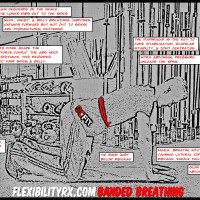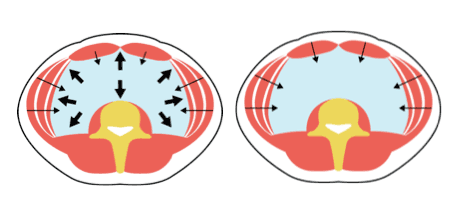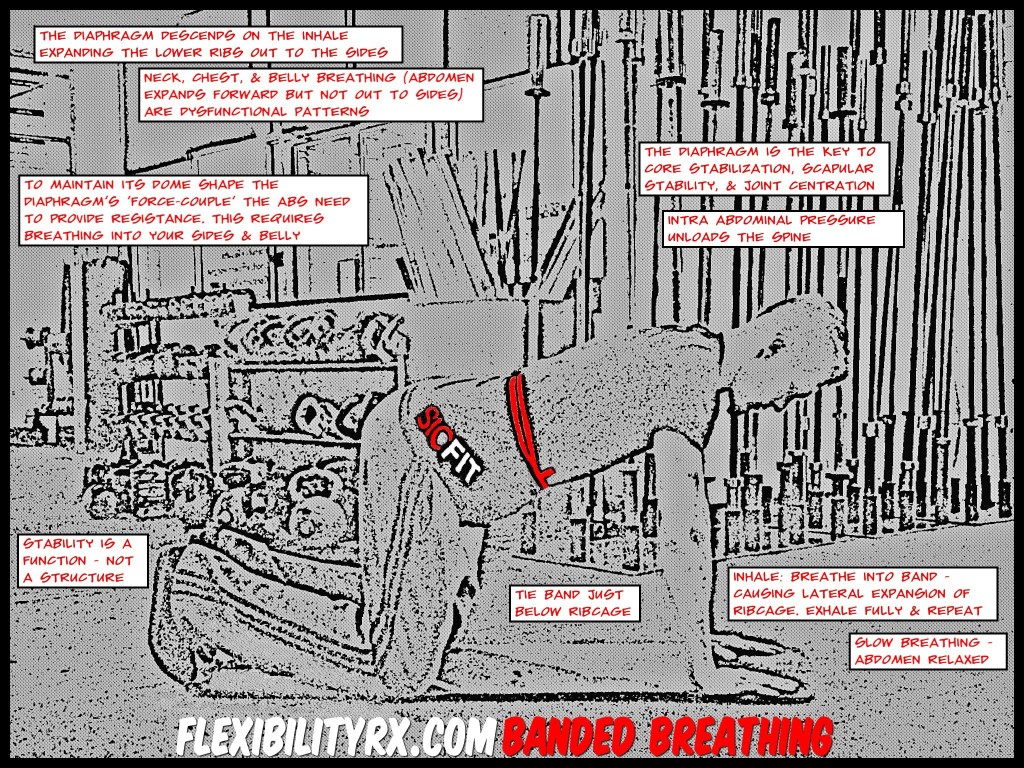
Banded Breathing for Core Stability
This exercise restores diaphragm function for improved core stability. A band is tied around the lower ribcage to encourage lateral expansion of the lower ribcage.
Diaphragmatic breathing is different than chest breathing and often confused with belly breathing. If you are just breathing into your belly and not expanding the sides of your ribs as the diaphragm pushes down – you are stuck in a dysfunctional breathing pattern.
The banded breathing exercise will teach you to breathe into your sides creating a lateral expansion of the ribcage.
Core Stability and Breathing
Diaphragmatic breathing is true core stabilization. The diaphragm performs dual roles: respiration and core stabilization. Dysfunctional breathing decreases the diaphragm’s function as a lumbo-pelvic stabilizer.
During one rep max efforts and heavy lifts the downward contraction of the diaphragm is what stabilizes the lumbar spine. The lumbar spine at L4/5 is the area where loading is most prominent and susceptible to injury. The diaphragm acts like a piston pushing down on the inhale to create intra-abdominal pressure.
Hans Lindgren in his article, “Core Stability from the Inside Out” explains that,
“People have to stop treating the core as a hollow tube and learn how to pressurize the “centre” of the tube instead of just tensing the walls.”

The Abdominals Role in Breathing
The abdominals play an important part in breathing: they provide counter-pressure to the contraction of the diaphragm – see illustration above. This resistance from the abdominals helps fix the ribcage down and prevents hyperextension of the low-back. Weak abdominals – especially in athletes with anterior pelvic tilt – destabilize the spine and restrict the diaphragm’s function for both respiration and midline stabilization.
The Diaphragm’s Role in Scapular Stability
While scapular stability is dependent on the function of the upward rotators (serratus anterior, upper and lower trapezius) their function is dependent on thoracic position and diaphragmatic breathing. DNS Practitioner – Hans Lindgren explains:
“When asked which muscle is the most important in providing scapular stability I am sure most people would think of the serratus anterior or the mid and lower trapezius. I would probably have done the same before I started to study with Pavel Kolar in the DNS program.”
“My answer to that question would now be the Diaphragm.”
He goes on to explain that,
“The stabilizers of the scapula, as well as all other muscles, need a fixed anchor point to pull towards. That anchor point in this case is the ribcage and the “core” all stabilized by the diaphragmatic contraction.”
The band used is a red EliteFTS Pro Mini Resistance Band. This band can be used for half-kneeling face pulls, rotatory band planks, banded breathing, and shoulder mobility exercises.
Thanks to Dean Somerset for posting the banded breathing video on YouTube.
Related Resources
Hans Lindgren DC: Scapular Stabilization (link)
Dean Somerset: Banded Breathing YouTube Video (link)
Mike Reinold: Core Stability from the Inside Out (link)
Tags: banded breathing, core stability, diaphragm contraction, diaphragmatic breathing, inside-out core stability, intra-abdominal pressure, scapular stability, weight-belt, weightlifting

Leave A Reply (No comments so far)
You must be logged in to post a comment.
No comments yet